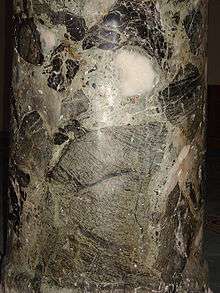Verd antique

Verd antique (obsolete French, from Italian, verde antico, "ancient green"), or verde antique, is a serpentinite breccia[1] popular since ancient times as a decorative facing stone. It is a dark, dull green, white-mottled (or white-veined) serpentine, mixed with calcite, dolomite, or magnesite, which takes a high polish.[2] It is sometimes classed, erroneously, as a variety of marble ("serpentine marble", "Connemara marble", "Moriah stone", etc.). It has also been called and marketed as "ophicalcite" or "ophite".[3]
Non-brecciated varieties of a very similar serpentinite, sometimes also called "verd antique", have been quarried at Victorville, California;[4] Cardiff, Maryland;[5] and Rochester in Addison County, Vermont.[6]
Uses
Verd antique is used like marble especially in interior decoration and occasionally as outdoor trim, although the masses are frequently jointed and often only small slabs can be secured. It was known to the ancient Romans and was quarried especially at Casambala, near Larissa, Thessaly, in Greece.[7] Verd antique was much used by the monumental builders of the Byzantine Empire and by the Ottomans after them. The term "verd antique" has been documented in English texts as early as 1745.
References
- ↑ Hager, Albert D. and Billings, E. Report on the Economical Geology, Physical Geography and Scenery of Vermont. Claremont, N.H.: Claremont Manufacturing Co., 1862, p. 50.
- ↑ Schumann, Walter. Gemstones of the World. Rev. and exp. 4th ed. New York: Sterling Publishing Company, 2009, p. 218.
- ↑ Dedyne, Roger and Quintens, Ivo. Tables of Gemstone Identification. Gent, Belgium: Glirico, 2007, p. 73.
- ↑ MacFall, Russell P. Gem Hunter's Guide. New York: Thomas Y. Crowell Company, 1975, p. 140.
- ↑ "Notes From the Stone Fields." Stone. 35:1 (January 1914), p. 50.
- ↑ Hitchcock, Edward. Report on the Geology of Vermont: Descriptive, Theoretical, Economical, and Scenographical. Proctorsville, Vt.: Vermont State Legislature, 1861, p. 534.
- ↑ DeJongh, Brian; Gandon, John; and Graham-Bell, Geoffrey. The Companion Guide to Mainland Greece. Woodbridge, Conn.: Companion Guides, 2000, p. 153.